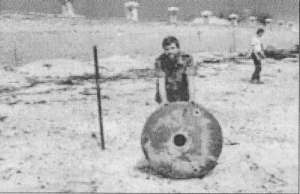- Author
- Maxwell, Eugene
- Subjects
- RAN operations, Post WWII
- Tags
-
- RAN Ships
- None noted.
- Publication
- December 2007 edition of the Naval Historical Review (all rights reserved)
Eugene Maxwell served as a Royal Australian Navy clearance diver from 1977 to 1998, reaching the rank of Chief Petty Officer. Within that time he served with the Clearance Diving Teams, the RAN Diving School, and the SAS Counter Terrorist Unit. He worked as a Diving/MK16 Instructor on exchange to the US Navy EOD training unit in Hawaii, and went to the Gulf War with CDT3.
CPOCD Maxwell retired from active service in October 1998 and is now employed as a regional manager with CABA Western Australia, specialists in life support equipment, hyperbarics, HP compressors, and service and support of the RAN’s A5800 (USN MK16) underwater breathing apparatus.
This article first appeared in D’ya Hear There, the newsletter of the Nautical History Foundation of Australia, November, 2002, and appears with the kind permission of Dive Pacific Magazine.
The twenty three men assembled in front of the aircraft hangar appeared a motley bunch, half wearing camouflage fatigues, half in navy blue overalls and one in civilian clothes – he had been abruptly recalled from his Christmas leave. On this hot summer afternoon at RAAF Pearce, Western Australia, Clearance Diving Team 3 was being reactivated. It was Sunday, 27 January 1991, and we were on our way to the Gulf War.
CDT3 is the clearance diving operational team mobilised whenever the Royal Australian Navy becomes involved in global conflict. Last activated for the Vietnam conflict, the team had been dormant since 1971. Our mobilisation was the culmination of immense frenetic activity, and after our equipment was loaded overnight into two C130 aircraft, we roared down the runway at 0900 the following morning and watched Australia disappear beneath us. Turning northwest, we settled down for the long trek to the Middle East and tried to imagine what lay in store for us. After touching down at Cocos Islands, Diego Garcia and Oman – and the small hiccup of having one engine shut down somewhere over the Indian Ocean – we emerged from the plane at Bahrain Airport to get our first glimpse of war.

The tarmac was abuzz with men and machinery. Military police drove past in a Jeep, grim-faced and with an M60 machine gun cocked and ready. Attack helicopters stood menacingly close, missiles in place, and glistening F18 fighter planes lined up for the quick sprint down the runway. We were moved into a hotel that teemed with war correspondents and had its windows dressed in masking tape – a paltry insurance should a Scud missile explode nearby. We carried gas masks everywhere we went against the possibility of a chemical attack, and brushed up on weapons drills at a local firing range. The wailing of air raid sirens was a familiar sound, and one morning we were woken abruptly by a number of loud explosions as Patriot missiles lifted off to intercept a deadly Scud intruder.
As the days went by, we watched the war on CNN while waiting for our orders to come through, and made good use of the time by conducting workups on all our equipment. We received a rude shock when the perceived clear, warm waters of the Arabian Gulf turned out to be extremely cold, with a muddy seabed that allowed limited visibility.
It was 4 March before we were told to pack for the move north. The next day we crossed onto Kuwait soil, and with 25 tonnes of equipment hauled on three semi-trailers and two five-ton trucks, we made our way to the port of Ash Shu’Aybah. The closest deepwater port to Kuwait city, it was to be cleared with great urgency to allow relief supplies and desperately needed food and water to be offloaded from waiting ships. As our slow procession moved steadily forward, the northern horizon took on an orange glow as the oil fires – the last defiant act of the Iraqi occupation forces – came into view. As we passed through an oil refinery adjacent to the port, a sabotaged pipeline spewed flames and thick oily black smoke 100 metres into the air. Though we passed 300m to the north of the fire, its fiery heat warmed our faces and lit up the surrounding countryside like a night sun.




